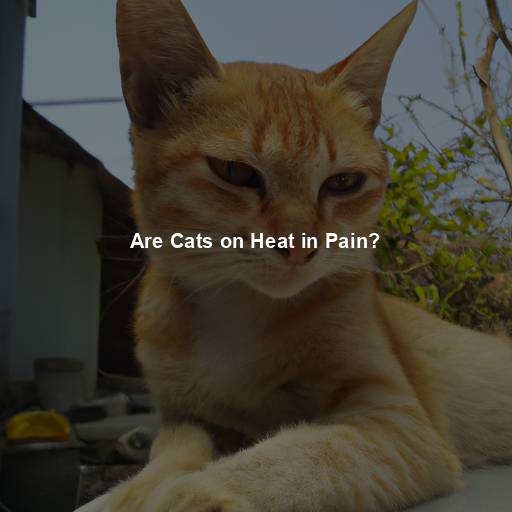Do Cats Spray When They Are in Heat?
Last Updated on October 28, 2023 by Evan
Contents
- 1 Understanding Feline Behavior
- 2 The Heat Cycle in Female Cats
- 3 Understanding Spraying Behavior
- 4 Spraying Behavior and Heat Cycles
- 5 Managing Spraying Behavior
- 6 Medical Considerations
- 7 FAQs: When Cats are in Heat, Do They Spray?
- 7.1 #1. Do female cats spray when they are in heat?
- 7.2 #2. Can male cats spray when they are around a female cat in heat?
- 7.3 #3. Is spraying urine during heat something that all male cats do?
- 7.4 #4. How can I prevent my male cat from spraying during a female cat’s heat cycle?
- 7.5 #5. Are there any other reasons why cats may spray besides being in heat?
- 7.6 #6. Can female cats spray urine after being spayed?
Understanding Feline Behavior
Cats are fascinating creatures, known for their independence, grace, and occasional aloofness. As pet owners, it is essential for us to understand their behavior and provide them with the care they need. One common behavior that can puzzle cat owners is spraying. The act of spraying is often associated with marking territory, but does it occur when cats are in heat?
The Heat Cycle in Female Cats
Have you ever wondered about the mysterious behaviors of female cats during their heat cycle? Unlike humans, who have regular menstrual cycles, female cats experience something called estrus. This fascinating cycle is marked by hormonal shifts and the desire to mate. However, the duration and frequency of estrus can be quite perplexing, as it varies from cat to cat.
When female cats enter their estrus period, they undergo a whirlwind of fascinating transformations that can leave us both amazed and perplexed. From sudden bursts of melodious meows to an unquenchable thirst for human affection, the enigmatic behavior of these feline goddesses never fails to captivate our attention. But it doesn’t stop there – they take it up a notch and showcase their flexibility by performing acrobatic floor rolls, inviting anyone who watches to delve deeper into their mysterious world. As if that wasn’t enough, they strike a pose that could rival any supermodel, with a raised hind end, gracefully curved tail, and a humbled head, inviting suitors to decipher the ancient language of love.
The Role of Hormones
Hormones play a crucial role in a cat’s heat cycle. When a female cat is in heat, her body releases pheromones that can attract male cats from miles away. These pheromones are present in the cat’s urine and are released through spraying. However, spraying behavior is not limited to female cats in heat.
Understanding Spraying Behavior
It’s a curious feline phenomenon – the enigmatic act of spraying. Cats, masters of the mystifying, employ this behavior to leave their indelible mark on the world, asserting their dominion over territory, forging connections with their peers, and even venting their deepest emotions. Unveiling a distinct twist from the conventional urination ritual, spraying unveils itself as a delicate dance, a dabble of urine on vertical canvases like walls and furniture. While unneutered males tend to embrace this art form with heightened fervor, females too can partake in its perplexing allure.
Territorial Marking
It’s no secret that feline creatures have their own fascinating ways of communicating and asserting their authority. One curious method they employ is spraying, a behavior commonly associated with marking their territory. This peculiar act involves the release of a distinct scent through the power of urine, a means for cats to stake their claim on certain areas. While unneutered males take the crown for indulging in this territorial display, it’s worth noting that their neutered counterparts and even female felines can also surprise us with their spraying prowess.
Communication and Emotional Expression
Cats, with their complex behaviors, seem to have a mysterious world of their own. It turns out, spraying is not just a simple act of marking territory but also a peculiar form of communication. The pungent scent in their urine carries messages that can range from cautionary signals to intriguing mating indicators, and even a display of their emotional state. In homes with multiple cats, spraying becomes an enigmatic ritual to establish social hierarchies or settle elusive feline conflicts.
Spraying Behavior and Heat Cycles
As our knowledge deepens concerning the intricate interplay of feline heat cycles and their mysterious spraying tendencies, we find ourselves faced with an enigmatic query: does the elusive act of spraying coincide with a cat’s state of heat? Alas, the answer to this enigmatic question does not walk a path illuminated with absolute certainty. It meanders through a labyrinth of perplexities, where definitive yeses and noes do not easily find their place.
While spraying is more commonly associated with male cats and territorial marking, female cats in heat may also engage in spraying behavior. During the estrus period, female cats produce pheromones that can attract potential mates. Spraying urine can help disseminate these pheromones and signal their availability for mating.
It’s important to understand that not every female cat in heat will display spraying behavior. The frequency and intensity of spraying can differ between individual cats. Various factors, like their surroundings, social dynamics, and overall temperament, can play a role in determining whether a female cat will engage in spraying during heat.
Managing Spraying Behavior
If your female cat is spraying during her heat cycle and it becomes problematic or disruptive, there are steps you can take to manage the behavior.
- Spaying: Consider having your female cat spayed. Spaying not only prevents unwanted pregnancies but also helps reduce hormonal fluctuations that can contribute to spraying behavior.
Creating a comfortable environment for your feline friend is vital, so make sure to provide ample resources. It’s essential to have clean litter boxes placed in serene and secluded areas, allowing your cat to have privacy and peace of mind. Consider having multiple litter boxes spread across different spots, as this can alleviate stress and deter spraying behavior, providing a harmonious space for your furry companion.
Enhance your feline friend’s surroundings with a burst of vibrant stimuli! Unleash their wild instincts with engaging scratching posts, captivating interactive toys, and soaring vertical havens for them to conquer. By enriching their habitat, you’ll unravel the perplexity of their spraying behavior and plunge them into a captivating realm of heightened contentment.
If your feline companion continues to engage in the perplexing act of spraying or if this behavior seems to escalate, seeking guidance from a seasoned veterinarian is strongly recommended. By thoroughly examining your cat’s general well-being and behavioral patterns, these experts will be able to offer valuable insights, along with suggesting potential remedies or techniques for behavior modification. Don’t let this burst of perplexity leave you feeling helpless. Seek professional advice to find a resolution that benefits both you and your furry friend.
Navigating the enigmatic world of our feline friends can often leave us in a state of bewilderment. One of the most perplexing behaviors that cat owners encounter is spraying. However, fear not for there is a glimmer of hope amidst the confusion. By embracing patience and demonstrating unwavering care, we can unravel the mysteries behind this peculiar behavior and create a harmonious bond with our beloved furry companions.
The Role of Neutering
When it comes to our feline friends, neutering is an imperative procedure that veterinarians highly recommend. Not only does it prevent the occurrence of unwanted litters, but it also plays a vital role in curbing spraying behavior. This simple yet crucial measure leaves our furry companions happier and more content, while simultaneously ensuring a healthier and more serene household. Embrace the power of neutering and witness the transformative effects it brings to your cat’s life.
Male Cats
For male cats, neutering can greatly reduce or even eliminate spraying behavior. This is because neutering removes the source of testosterone, a hormone that plays a crucial role in territorial marking and mating behavior. By reducing testosterone levels, neutering can help calm the cat’s urge to mark its territory through spraying.
Female Cats
When it comes to our feline friends, spaying female cats can work wonders to tackle the mysterious world of spraying behavior. By skillfully removing the ovaries and uterus, we embark on a transformative journey that calms the storm of hormonal fluctuations during the heat cycle. It’s almost like unraveling the perplexities of a maze, where the urge to spray, even during the fiery heat, starts to dwindle into the land of tranquility.
It’s important to note that while neutering can be effective in reducing spraying behavior, it may not completely eliminate it in all cases. Individual variations in behavior and environmental factors can still influence spraying tendencies, even after neutering.
Cleanliness and Odor Removal
Ensuring a clean and odor-free environment is essential when managing spraying behavior. Regularly clean and disinfect areas where spraying has occurred to remove any lingering scent that may encourage repeat spraying. Using enzyme-based cleaners can help break down the odor molecules and eliminate them effectively.
Environmental Modifications
Creating a stimulating and enriching environment for our feline friends can work wonders in curbing their spraying tendencies. By introducing interactive toys, scratching posts, and perches, we can provide them with the mental and physical stimulation they need, helping divert their attention away from territorial marking. Furthermore, strategically placing litter boxes in various locations throughout the house can offer them more options for relieving themselves, reducing the urge to spray. Finally, employing pheromone sprays or diffusers can create a calming atmosphere, alleviating any stress or anxiety that may trigger spraying behavior.
Creating a harmonious living environment for our feline friends is no small feat, especially when it comes to their bathroom needs. To alleviate any potential furry disputes, consider providing a smorgasbord of litter boxes in strategic locations. By offering multiple options, cats can stake their claim without feeling the need to resort to territorial sprays. So go ahead and indulge in some feline real estate, ensuring peace and cleanliness for every whiskered inhabitant.
-
Create vertical spaces and hiding spots in your home. Cats feel more secure when they have elevated areas to climb and observe their surroundings. Providing cat trees, shelves, or perches can help alleviate stress and reduce the likelihood of spraying.
-
Use pheromone diffusers or sprays. Feline pheromones, such as synthetic versions of the facial pheromone Feliway, can help create a calming environment and reduce spraying behavior. These products can be useful in conjunction with other management techniques.
Behavioral Enrichment
Discover the secrets to diverting your feline friend’s attention from those pesky spraying episodes. Unleash the power of interactive play, captivating their curious minds and redirecting their vivacious energy. Delve into the world of puzzle feeders, engaging their primal instincts and stimulating their mental faculties. Unlock the door to clicker training, a captivating method that will keep their brains busy and their mischievous tendencies at bay.
Consult with a Behaviorist
If your furry feline friend continues to engage in the perplexing act of spraying, despite your valiant attempts to curb their behavior, it could be highly advantageous to seek guidance from a seasoned professional in the field of animal behavior. These knowledgeable individuals possess the uncanny ability to meticulously assess your cat’s idiosyncratic circumstances, unearthing any hidden complexities or potential psychological underpinnings. Armed with this invaluable insight, they can craft bespoke behavior modification strategies, tailor-made to tackle the enigmatic issue of spraying with precision, while also shedding light on the enigmatic triggers and stressors within your cat’s unique habitat.
The Relationship Between Stress and Spraying
It’s incredibly fascinating how stress can truly throw our feline friends for a loop, and one way they express their inner turmoil is through spraying. Cats are such delicate creatures, always on the verge of a complete emotional 180. Any slight change in their surroundings or daily routine can send them spiraling into a spraying frenzy as a means of self-soothing. Only by delving into the perplexing connection between stress and spraying can we hope to navigate this behavior with finesse and grace.
Environmental Stressors
Various factors in a cat’s environment can contribute to stress and trigger spraying behavior. These may include:
- Changes in the household, such as the introduction of a new pet or family member.
Decorating and transforming your living space with a fresh perspective can be both energizing and perplexing. Whether you’re embarking on the journey of moving into a new home or simply rearranging your furniture, it’s an opportune time to embrace bursts of creativity and create an atmosphere that truly reflects your unique style. Feel the thrill of uncertainty as you meticulously arrange each piece, experiencing the joyful mixture of anticipation and puzzlement that accompanies this transformative process. With every step, you’ll witness your home coming to life, bursting with the harmonious fusion of excitement and bewilderment.
The cacophony of loud noises and the whirlwind of excessive commotion can be quite overwhelming to the senses. It leaves one in a state of perplexity, unable to find solace amidst the chaos. Like a deafening storm, it disrupts the peace and tranquility that one seeks in the pursuit of a serene existence. - Lack of vertical spaces or hiding spots.
In a world of scarcity and unpredictability, our furry companions often face the same challenges as us humans. From a lack of nourishment to insufficient hydration, they too must navigate the treacherous path of limited resources. Not only that, but even something as seemingly mundane as finding an empty litter box can become a perplexing journey for these feline friends. So, let us extend our empathy to their world and ensure they have everything they need to thrive amidst the chaos.
Living with multiple cats can sometimes bring about some challenges in maintaining a harmonious household. It’s not uncommon to encounter conflicts or tensions among our feline friends when sharing the same living space. These situations can leave cat owners feeling perplexed and unsure of how to best address the burst of dynamics in their furry family.
Understanding and effectively resolving the various factors contributing to environmental stress can prove instrumental in curbing the prevalence of spraying behavior. By pinpointing these stressors and implementing appropriate measures, it becomes possible to mitigate the occurrence of this behavior and promote a more harmonious environment.
Minimizing Stress for Cats
In our fast-paced world filled with constant demands and pressures, finding ways to reduce stress and discourage unwanted behaviors can be a perplexing challenge. Fortunately, we have curated a collection of strategies that may offer some relief. From mindfulness techniques to promoting a calm environment, these suggestions are bursting with potential solutions to help you and your furry friend navigate the complexities of day-to-day life with more ease and harmony.
Creating a consistent routine and a cozy environment for your feline companion is essential for their well-being. By establishing a predictable schedule and keeping their living surroundings harmonious, you can help alleviate any unnecessary anxiety or tension they might feel. Embracing stability and minimizing disruptions will contribute to a happier, more contented cat.
- Create safe spaces for your cat. Ensure that your cat has access to hiding spots, elevated areas, and cozy retreats where they can feel secure and escape from potential stressors.
Encourage a harmonious bond with your feline companion through the power of positive reinforcement. When your cat exhibits behaviors that warm your heart, indulge them with delicious treats, lavish praise, or engage in playful interactions. By doing so, you are creating a delightful and stress-free environment while building a strong connection with your furry friend.
- Consider pheromone therapy. Synthetic feline pheromones, such as Feliway, can help create a calming environment for your cat. These products are available in diffusers, sprays, or collars and can be effective in reducing stress-related spraying behavior.
Creating a dynamic and stimulating environment for your feline friend is key to keeping them content and mentally sharp. Encourage various forms of interactive play, ranging from feather wands to laser pointers, to captivate their curiosity. Implementing scratching posts and offering puzzle toys or treat dispensers will not only challenge their cognitive abilities but also alleviate any potential bouts of boredom.
Creating a stress-free haven for your feline friend is key in curbing those unwanted spray incidents. By providing a calming atmosphere and removing potential stressors, you can significantly decrease the chances of your cat engaging in this perplexing behavior. Embrace strategies that promote a harmonious living space, such as providing ample hiding spots and implementing engaging activities, to keep your cat content and minimize the chance of spraying mishaps.
Medical Considerations
When it comes to spraying behavior, it’s crucial to delve beyond the surface and consider not only the common culprits like stress and behavioral factors but also the possibility of underlying medical conditions that might be at play. Unwanted urination or spraying can sometimes be fueled by a range of medical issues that ought to be explored to shed light on the perplexing situation. Understanding the potential medical causes can help us navigate the puzzle and address the problem more effectively.
- Urinary tract infections
Dealing with bladder stones or obstructions can throw your urinary system a curveball, causing discomfort and interfering with your daily routine. These pesky little troublemakers are like obstacles obstructing the smooth flow of urine, leaving you puzzled about the cause. Don’t let your urinary health be overshadowed by the burst of perplexity; consult a healthcare professional to get the right diagnosis and embark on the journey towards relief and clarity.
Feline lower urinary tract disease, commonly known as FLUTD, is a perplexing and often puzzling condition that affects our beloved feline friends. It is characterized by a burst of symptoms that can leave both cats and their owners feeling confused and concerned. From frequent urination and urinary accidents to painful urination or even blockages, FLUTD presents a perplexing challenge for veterinarians and caregivers alike. However, with the right knowledge and proactive measures, we can navigate this enigmatic condition and provide the best care for our feline companions. - Diabetes
Kidney disease, a perplexing and often misunderstood condition, affects millions of people worldwide. With its burst of symptoms and varying degrees of severity, this enigmatic ailment poses numerous challenges to patients and medical professionals alike. From the puzzling causes to the bewildering treatment options, navigating the complex landscape of kidney disease can leave anyone feeling perplexed. However, amidst the uncertainty, there is hope – ongoing research and advancements in medical science continue to shed light on this intricate puzzle, offering glimpses of a brighter future for those affected by this debilitating condition.
Are you finding yourself in a perplexing situation with your feline friend’s persistent spraying antics? It’s time to put those worries to rest and seek advice from a knowledgeable veterinarian. With their expertise, they can dive deep into the mysterious world of your cat’s urinary issues, conducting comprehensive examinations and diagnostic tests to unravel the enigma. Once potential medical causes are ruled out, they’ll expertly guide you through tailored treatment plans or management strategies to nip this spraying behavior in the bud.
FAQs: When Cats are in Heat, Do They Spray?
#1. Do female cats spray when they are in heat?
Contrary to popular belief, female cats do not engage in spraying when in heat. While male cats mark territory by spraying, their female counterparts opt for different tactics during their heat cycles. These include vocalizing loudly, appearing restless, urinating more frequently, rubbing against objects, and assuming a mating position to attract male suitors. So, there’s no need to worry about your female cat leaving unwanted marks around the house during her heat.
#2. Can male cats spray when they are around a female cat in heat?
It’s no secret that when a female cat is in heat, male cats tend to get a bit more, well, expressive. The smell of a female cat in the throes of her heat cycle can awaken something primal in the male cats, prompting them to mark their territory with a spray of urine. This seemingly bizarre behavior is actually their way of broadcasting their presence and announcing their readiness to other male felines in the area.
#3. Is spraying urine during heat something that all male cats do?
It’s a curious and puzzling phenomenon that not all Tomcats resort to the act of spraying when a female feline is in heat, despite it being a prevailing behavior among intact males. Nevertheless, the key lies in the transformative power of neutering, which can drastically minimize or completely eradicate this perplexing habit. By curbing their hormonal instincts and diminishing the urge to assert dominance through territorial marking, the process of neutering offers respite and resolves this enigmatic issue for our feline companions.
#4. How can I prevent my male cat from spraying during a female cat’s heat cycle?
If you’re finding yourself in a perplexing situation with your male cat’s incessant spraying during a female cat’s heat cycle, fear not! There’s a burst of hope called neutering that can come to the rescue. By snipping the wires, you not only reduce the chances of your furry friend turning into a modern-day Picasso with their spraying antics, but you also unlock a treasure trove of health benefits and shield them from pesky reproductive diseases. As a bonus, neutering might just be the ticket to curbing their adventurous escapades and taming any unwanted aggression, transforming them into the purrfect companion for your cozy household.
#5. Are there any other reasons why cats may spray besides being in heat?
Yes, cats may spray for various reasons other than being in heat. Common reasons for spraying include marking territory, responding to changes or stress in their environment, expressing their displeasure or anxiety, and even as a result of medical conditions such as urinary tract infections or bladder issues. If you notice your cat frequently spraying or if there are any sudden changes in their spraying behavior, it is recommended to consult a veterinarian to rule out any underlying medical conditions.
#6. Can female cats spray urine after being spayed?
Spraying behavior in female cats might not be as prevalent as in males, but don’t be perplexed if your spayed female kitty occasionally lets loose a little urine spray. This burst of behavior can happen, but fear not—once your cat is spayed, those hormonal changes should help curb the desire to mark territory or attract potential mates. However, if your lady cat persistently sprays, it’s best to seek the guidance of a veterinarian who can help identify any underlying issues and offer behavioral tips to keep things in purrfect harmony.







